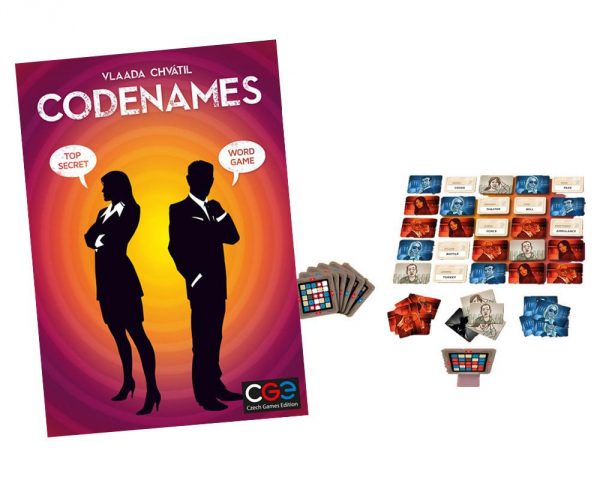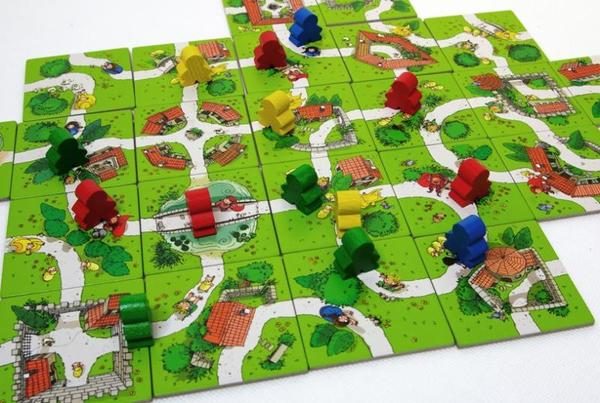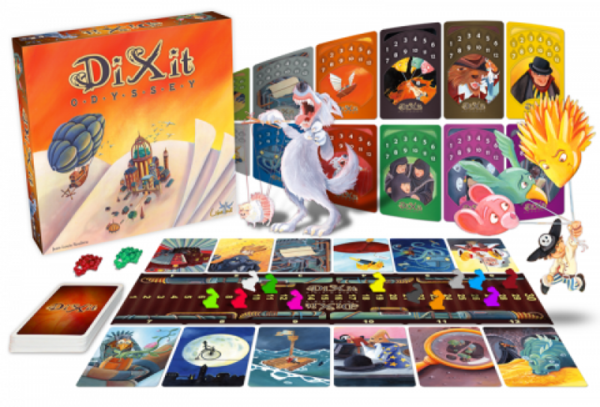Sign-up to our mailing list
The Best Family Games for the Holiday
 Q: When is it the right time to play games?
Q: When is it the right time to play games?
A: Anytime. But especially when it’s holiday season.
Holidays and festivities abound throughout the year – but there’s something about nearing the end of a year that ramps up the festive season feelings. As we approach some goliath holidays between now and the new year, the number of get-togethers is on the rise. And, not remotely biased at all, we feel that one of the best ways to spend those get-togethers is by playing board games.
Although holiday-themed films and TV are a tempting post-festive-feast activity, the quality family/friend time you get over the holidays is also worth spending on some less passive activities too. Hence the need for some brilliant family games for the holiday.
This brings up the question: what makes a good holiday game? We’re of the opinion that a good holiday game doesn’t have to be festive in itself. That is, you don’t need a game adorned with tinsel, all about placing the nose on a reindeer, or on some snowflake-themed board. Instead, we feel that the best games are the ones that bring everyone together (yes, we know it’s cliche); one that all age groups can enjoy and feel genuinely involved in.
There’s lots of brilliant games that tick these boxes, but these are the ones we think really do the job best. So, without further ado, here are our top 7 family games to play over the holiday season.
Article Contents
- 1. Dancing Eggs – A ridiculously fun game for everyone
- 2. Codenames – a deduction game that stays fun
- 3. Beasts of Balance – The digital and physical stacking game for the whole family
- 4. Chameleon – A moreishly fun deduction game
- 5. Carcassonne – An easy-to-pick-up tile laying game
- 6. Dixit – A storytelling game for groups
- 7. Articulate – A classic family party game
1. Dancing Eggs – A ridiculously fun game for everyone

This game is as ridiculous as its name suggests – but that’s one of the best things about it. Before you even begin playing the game, you can tell this is not your typical board game simply by looking at the pieces. Now, defining what a ‘typical board game’ looks like is a challenge in itself – but we probably all agree that it doesn’t tend to come in an egg carton.
That is exactly (or egg-sactly, perhaps) what you get with Dancing Eggs, though: an egg carton full of rubber eggs, plus one wooden egg, and two large wooden dice. These are all great quality, and feel nice to use – which is good, as this is a pretty hands-on game. Depending on the dice roll, players will attempt to catch, take or steal eggs in order to get points, and then store those eggs around their body in peculiar ways. This can result in some rather amusing postures of people sitting around the table – one person may be sitting with an egg under their chin, another person with two eggs in the crooks of their elbows.
The game can get even more physical than this depending on the challenges you get – for example, racing around the table…whilst still balancing the eggs you’ve got in place. If the appeal of Dancing Eggs isn’t apparent yet, just try picturing your mum or best friend – or just about anyone, really – hobbling around a table with a tiny rubber egg between their legs.
The evident ridiculousness of this game softens the competitive edge, which is great when playing with younger kids; even if someone doesn’t win, they’ll still feel like they’ve gotten something (most likely an amusing memory) out of the game. Although it’s not always easy to pick up the eggs, it is easy to pick up the rules – so for a light-hearted game that everyone can enjoy, Dancing Eggs is worth a play.
2. Codenames – a deduction game that stays fun

Codenames is rather different to Dancing Eggs. It’s become a fast favourite in a lot of households, but in case you haven’t heard about it before here’s a quick primer:
In Codenames there are two teams, each one helmed by a Spymaster. Each Spymaster is trying to get their team to uncover their group of secret agents, without unveiling the agents of the other team. Both teams are also trying to avoid the assassin, who will automatically result in the other team winning the game when discovered.
This is all carried out over a set of tiles, which have random words on them. On the other side of the tiles (which only the Spymaster knows about), is the tile’s assigned agent. The Spymaster must then come up with a word that will hint to their team which tiles they should pick, trying to find a clue that ties them together clearly – but without causing them to pick the opposing team’s tiles (or the assassin!).
This principle – of choosing a hint word, followed by a number to suggest the number of tiles affected – makes up the whole game. But because everybody sees things from in different ways, the game doesn’t get stale. For example, whilst one person may use the word ‘fly’ to clue you in on an insect card, another person might interpret ‘fly’ as a hint to an airplane card – or, depending on how dated your slang is, they may be clueing you in on something pretty cool.
Trying to deduce the Spymaster’s clues by travelling through their thought patterns, and vice versa, makes the game really absorbing and fun. If you take it in turns playing as the Spymaster as well, this lets everyone a chance to try different sides of the game, each with their own unique and fun elements.
Whilst you can play Codenames with slightly adjusted rules for 2 or 3 players, it’s definitely a fun game to play with larger groups. Whether you are familiar with a teammate and trying to use that to your advantage in understanding their clues, or you’re playing the game as an icebreaker, Codenames is a fun party game to play over the holidays.
3. Beasts of Balance – The digital and physical stacking game for the whole family

We’ve got to suggest Beasts of Balance as a brilliant choice for a family game for the holiday – it’s one we’ve played numerous times in our own homes over the festive period!
Beasts of Balance is a cooperative stacking game, which combines physical and digital gameplay. Any physical artefacts you scan and stack on the tower affect the digital world you’re simultaneously creating on your smartphone or tablet.
We recommend this as a family holiday game because it can be enjoyed even at its most basic level: stacking bright and beautiful objects and creating weird and wonderful creatures in your digital world (curious what a Swinejaw is, anyone? Or perhaps a Gilded Bulette?) At the same time, if you so choose, you can play more strategically, balancing which pieces are best for the physical part of the game against what is best for your digital world.
Because there are many ways to play, it’s both easy to pick up for various age groups, and also a game you discover more value in the more you play. On top of this, because the number of players is flexible it’s great for getting everyone involved – in fact, you’ll probably need all hands on deck when your tower collapses!
4. Chameleon – A moreishly fun deduction game

If light bluffing games are your thing, look no further than Chameleon. This is a quick game that can be played in as little as 10 minutes, which makes it a great moreish game, or an easy palate cleanser between longer games.
In Chameleon, everybody gets a set of cards that clues them in on the words being chosen – everyone, that is, except the Chameleon. As everybody goes around the table, they give a clue about the word at hand – not unlike Codenames – only you don’t want to make it too obvious, or else the Chameleon will catch on. Once everybody has had a go providing their clue, everybody votes on who they think the Chameleon is. If the majority guess correct, they win – if not, the Chameleon wins.
This is a light and simple game, with less pressure on being a master liar and more on being a master of logical deduction. This means that even those who aren’t so good at bluffing can get comfortable with being the Chameleon. Another nice touch is that you can also create a personalised grid of words outside of those provided in the box, so if you’re with close family or friends you can create a set of words that has extra meaning (and, most likely, amusement) for your particular group.
5. Carcassonne – An easy-to-pick-up tile laying game

Carcassonne is a tile-laying game based on the city of the same name in France. In this game, players act as the founders of the Carcassonne area, taking it in turns to draw and place tiles to make their cities the most impressive (and high-scoring) of them all.
One of the nice things about Carcassonne that makes it a good family holiday game is that it is easy to pick up. This is largely because there are only two types of action every player needs to take. The first is to draw and place a tile, making sure that the edges of the tile you place match the edges of those around it. The second move is to place your meeples onto the feature on the tiles you want to occupy (on a road or city, for example).
And that’s it – congratulations, you pretty much know how to play the game! Of course, from here you can get more strategic about where you place your tiles and meeples, but having the main actions be so straightforward means that people that are new to boardgames can also get the hang of it quickly. Additionally, at the end of the game, you are also left with a wide-sprawling, organic and wonderful landscape that documents you and your fellow players’ journey creating Carcassonne. On top of this, you can choose to play more benevolently, or ruthlessly – so depending on the crowd you are with, you can experience different sides of the game.
6. Dixit – A storytelling game for groups

If you’re looking for a creative, more abstract sort of game, then Dixit is the game for you. There isn’t any written text in Dixit, but there are a lot of fantastical looking cards. So who provides the words? You do.
In Dixit, everyone has their own hand of cards. People then take it in turns being the storyteller, where they describe the picture on their card however they like. For example, they can use one word, a phrase, a poem; as long as they’ve conveyed it in some way, they’ve done your job. After this, the storyteller puts their chosen card forward, alongside the cards of other players who have also picked a card they think matches the Storyteller’s description. All of the chosen cards are then revealed, and players need to guess which one they think belonged to the Storyteller. If anybody guesses the Storyteller’s card correctly, they and the Storyteller both get points – but if everybody guesses the Storyteller’s card, then the Storyteller doesn’t get any points.
It’s this rule that requires the Storyteller be a little more adroit with their descriptions, making them clear enough to be plausible, but not obvious enough to rule out any doubt of other cards. This can bring out some really creative and ingenious descriptions – and interpretations – of the cards. The atmosphere it creates it slightly dreamlike, and is brilliant for winding down a day of festivities.
7. Articulate – A classic family party game

The final game on our list is an old one, but a classic for family party fun. Articulate is a game where you are racing around a board, trying to move forward by describing words to your team so that they can guess them before time runs out. These words can vary in category, so there is a wide breadth of topics you could find yourself talking about.
Whilst this game may not be best for very young children (given the vocabulary requirements, this game is listed as being recommended for ages 12+), if you have slightly older kids, this is a fun game where everyone feels very engaged. With only 30 second bursts to either convey a word or decipher a description, there’s not really any chance to switch off! Plus, some of the descriptions that players come up with under time pressure can be hilarious enough gems in themselves, regardless of whether they help you progress or not.
This sums up our picks for the best family games for the holidays! If you want to keep up to date on more board game news and picks, or the best offers on Beasts of Balance, make sure to sign up to our mailing list through the signup below.

